2316
Views & Citations1316
Likes & Shares
Results: The First was to assess the demographic variable in experimental group. Majority of the Adolescent students 30(50.00%) were in the age group of (17-18) yrs. Majority of the of the Adolescent students 27(45.0%) Hindus. Majority of the of the Adolescent student’s mother’s education 27(45.0%) were Illiterates. Majority of the of the Adolescent student’s mother’s occupation 24(40%) were Housewife. Majority of the of the Adolescent students Fathers education 21(35.0%) were Illiterates. Majority of the of the Adolescent students Fathers occupation 27(45.0%) were private employees. Majority of the of the Adolescent students Income per month 33(55.0%) were belongs to 5,001/-10,000/- income per month. Majority of the of the Adolescent student’s resident 42(70.0%) were belongs to rural resident. Majority of Adolescent students 21(35.00%) belongs to three family’s members. Majority of the Adolescent students Family type 27(45.00%) were Joint family type. Majority of the Adolescent students 30(50.0%) had previous knowledge through mass media.
The pretest 54(90.0%) were having Below average knowledge, 6(10.0%) were having Average knowledge, 0(0%) were having Above average knowledge. For posttest 0(0.0%) were having Below average knowledge, 46(76.66%) were having Average knowledge, 14(23.33%) were having Above average knowledge. The mean pre-test knowledge score pretest score (m11.71+/- SD3.24) was less than the post-test knowledge score (m26 +1- SD2.94) Paired "t" value 51.35 table value: 2.023. value. computed between the pretest and posttest level of knowledge score. which was significantly at 0.05 level. So, the calculated" value is greater than tablet" value, the research hypothesis (H) is accepted. The tool used for the study was a structured learning program.
Conclusion: The study was conducted to evaluate the level of knowledge among Adolescents students studying at Sri Venkateshwara Junior college. knowledge mean score was 26 with the standard deviation 2.94 so the structured teaching program was an effective method to improve the knowledge.
Keywords: Assess substance abuse, Improve the knowledge regarding prevention of substance abuse, Adolescence age, Peer pressure acceptance in group, Modern trend
NEED FOR THE STUDY
The period of adolescents is not an easy stage of life. Many physical and emotional changes take place during adolescent's period. The period of adolescents is a critical one and that has many health-related beliefs, attitudes and behaviors are adopted and consolidated [5]. During this stage of life, adolescents have increased freedom to access to health compromising substances and experiences such as alcohol, tobacco, other drugs, and sexual risk taking as well as opportunities for health-enhancing experiences such as regular exercise and a healthy diet [6]. Estimating prevalence of alcohol use in the general population range from 26-50 % of all males. The survey generally show that many people are abstainers, some are drinkers and quite a few are heavy drinkers, with tendency among those who drink to indulge in very drinking, to get drunk rather than to aid mutual social activity. Health demands on adolescents cannot be ignored since they form an important part of the human resources of our country. Habits and behaviors (Food habits, substance abuse, conflict and emotional management, sexual expression) picked up during adolescence have life-long impact [6]. But it is considered that the physical manifestations of adolescents in substance abuse include alterations in vital signs, weight loss, chronic fatigue, chronic cough, respiratory congestion, red eyes, and general apathy and malaise. The mental status examination may reveal alterations in level of consciousness, impaired attention and concentration, impaired thought processes, delusions and hallucinations misdial thoughts are also common. Males have higher incidence for both non-dependent and dependent use for all the drug categories. Females had a higher incidence of dependent toward tobacco, Alcohol [7]. A study to estimate the prevalence rate of alcohol abuse and to study its socio- demographic correlates. Alcohol consumption is higher in rural areas of India compared to urban areas. Scheduled tribes have a higher prevalence of alcohol consumption compared to other castes or tribal groups. In terms of religious groups, the percentages of alcohol consumption are approximately as follows: Hindus 20%, Muslims 5%, Christians 28%, Sikhs 23.5%, Buddhist/Neo-Buddhist 24.5%, Jains 5.9%, and others 47%. A socio-demographic profile was also included to collect information on gender, race, age, level of education, professional program, health status, employment status and distance students who stayed at the university. Result indicated that urban university students’ overall knowledge of alcohol and alcohol effects were generally low. As saying goes, today's young people are tomorrow's future. Since the increasing rate of alcoholism among the youth of our country is alarmingly high, there is an urgent need for systematic initiation of preventive health education programs on alcoholism among the youth, most of which are contributed by the student population. Hence the investigator felt the need to conduct a study to evaluate the effectiveness of health education on alcoholism for undergraduate students. Telangana stand at the top among all the southern states when it comes to Consumption of alcohol as per the study is 43.4% and out of every 100 women 7 consumes alcohol, sangareddy rural the number of substance abuse among adolescents are 50-60% and cigarette smokers and alcohol abuse is 30-40%. Therefore, the investigator planned to conduct the study among adolescents in selected colleges because of the high prevalence of the problem among adolescents. The investigator planned to give health education regarding the prevention of substance abuse [8].
STATEMENT OF THE PROBLEM
"A study to assess knowledge regarding effectiveness of structured teaching program on prevention of substance abuse among adolescents in selected junior colleges at Sangareddy Telangana state”.
OBJECTIVES OF THE STUDY
To assess pre-test knowledge level of adolescents regarding prevention of substance abuse among adolescent students at selected junior colleges.
- To plan, validate and administer structured teaching program regarding prevention of substance abuse among adolescent students at selected junior colleges.
- To assess post-test level of knowledge level regarding prevention of substance abuse among adolescent students at selected junior colleges.
- To evaluate substance abuse among adolescent students at a selected high school effectiveness of a structured educational program in the field of prevention.
- To find out the association between post-test knowledge, scores of adolescents on prevention of substance abuse with their selected demographic variables among adolescent students at selected junior colleges.
HYPOTHESES OF THE STUDY
- H1: Their will be significant difference between pre and posttest level of knowledge regarding prevention of substance abuse among adolescents’ students at selected junior
- H2: There will be a significant association between posttest level of knowledge scores on prevention of substance abuse among adolescents and their demographic variables.
OPERATIONAL DEFINITION
Effectiveness: It refers to the significant gain in post knowledge level regarding prevention of Substance abuse which will be measured by the self-administered structured questionnaire prepared by the investigator for the purpose of the study.
Knowledge: Refers to correct responses from adolescent students regarding prevention of substance abuse.
Structured Teaching Programme on Prevention of Substance Abuse: For the purpose of this study, it refers to the systematically developed instructional and teaching aids designed for adolescent students regarding prevention of substance abuse like Alcohol - Beer, Wine, and Liquor. Opioid - Morphine, Heroin, Pentazocine, Pethidine.
Substance Abuse: For the purpose of this study, the following Substance alcohol wine, Liquor. Opioid - Morphine, Heroin, Pentazocine, Pethidine. Cannabinoids - Ganja, Hashish, Charas and Bhang. Sedatives and hypnotics-Barbiturates, Benzodiazepines. Cocaine Stimulants Caffeine, amphetamine, methylphenidate, Hallucinogen -LSD, dimethyl tryptamine, psilocybin Tobacco - Cigarettes, cigars, bidi, zarda, khaini Volatile solvents - Toluene, ethyl acetate
Abuse: Misuse of substance
Adolescents: They are adolescent students including both male and female studying in selected junior college students at Sangareddy.
Junior College: It refers to the period of age between 16 to 8 years of age.
Assumption:
- The students may have some knowledge regarding "substance abuse."
- The student may willingly participate in the study.
- Tool prepared may effectively assess the knowledge regarding "substance abuse."
Delimitation:
- The study is de-limited to adolescents of age 16 to 18 Yrs.
- The study is de-limited to adolescents in selected junior college.
- The data collection period is de-limited to 4 weeks.
Conceptual framework: Conceptualization refers to the process of developing and refining abstract ideas a conceptual model provides a logical thinking for systemic observation of interpreting the observed data if describes each of the concept shows in general way how the concept is related to one another. Conceptual framework for the present study is based on prevention of substance abuse among adolescents at selected junior colleges and providing structured teaching programs to improve knowledge. The development of conceptual theoretical framework is fundamental process required before conducting actual research teaching programs on knowledge regarding prevention of substance abuse. The study is based upon J.W. Kenny's open system model. The present study is aimed at developing and evaluating the effectiveness of structure.
Concepts: The concepts of J.W. Kenny's open system model are input, throughput, output, and feedback. The study was based upon J.W Kenny's open system model. All living systems are open in that there is continual exchange of matter energy and information. Open system has varying degree of interaction with the environment from which the system receiving input and gives back output in the form of matter energy and information for survival all systems most receive varying types and amount of information, matter of energy. Feedback may be possible, negative, or neutral. In this study the concepts have been modified as follows.
Input: According to J.W Kenny's input refers to matter, energy and information that enter the system through its boundary. In the present study the input was assessing the level of knowledge regarding prevention of substance abuse among adolescents at selected junior colleges.
Throughput: Throughput refers to processing where system transforms the energy matter and information. In this study throughput refers to the process of transferring the knowledge of structured teaching program to adolescent junior college students.
Output: It refers to the matter, energy and information that are processed. Output is the change level of knowledge regarding prevention of substance abuse among adolescents at selected junior college.
REVIEW OF LITERATURE
The literature reviewed for the present study is organized under the following headings:
- Epidemiology of substance abuse
- Effects of substance abuse
- Knowledge, attitude, and opinion regarding substance abuse
- Prevention and control of substance abuse
- Teaching strategies and development and evaluation of informational booklet
METHODOLOGY
Research methodology refers to a way of obtaining organizing and analyzing data [9-10].
Research approach:
- Evaluative research approach was adopted for the study.
- Research design: the research design adopted in this study is one group, pre-test and
- Post-test design
Setting of the Study
Setting refers to physical location and condition in which the data collection take place in the study. The present study was conducted at Sri Venkateshwara junior college, Sangareddy dist., Telangana state. which is a professional, co-educational college offering junior college all courses, the duration of the study will be 9 weeks.
Population
Population is the entire aggregation of cases on which a researcher is interested here the population is adolescent students who are studying at Sri Venkateshwara junior college.
Target Population is the aggregate of cases about which the researcher would like to make generalization. In the present study the target population was Adolescent junior college students who are studying at Sri Venkateswara junior college, Sangareddy dist.
Accessible Population is the aggregate of cases that confirm to the designated criteria and that are accessible as a pool of subjects for the study. The accessible population in this study was 60 adolescent students who are studying at Sri Venkateshwara junior college, Sangareddy district.
Sample and sampling techniques is a sample is a subset of population elements, which are the most basic units about which data are collected. The sample was chosen to represent the key characteristics of population, freeform bias, and errors, substitution, and completeness. The sample used for the present study was 60 Adolescent junior college students who are studying at Sri Venkateswara junior college, Sangareddy dist.
Sampling Techniques is the process of selecting a representative part of the population. in present study Stratified random sampling technique. For this study convenient sampling techniques was adopted to draw the sample.
Sample Size
The number of samples selected for this study is 60 adolescent students.
Criteria for Selection of Sample
Inclusion Criteria: Adolescent junior college students who are studying at Sri Venkateshwara junior college, Sangareddy dist., Telangana state.
- Adolescent students are those who are present and willing to participate in their studies.
- Adolescent students who can read and write Telugu or English.
Exclusion Criteria:
- Sick during the time of study.
- Not interesting to participate and those who have already attended previous seminars, workshop on prevention of substance abuse.
- Those who have age group below 15years.
Descriptive variables include in this study are
Independent variables: In this study independent variable are structure teaching program regarding prevention of substance abuse among adolescent students.
Dependent variables: The dependent variable in this study is Knowledge regarding prevention of substance abuse among adolescent students.
Extraneous variables: Extraneous variables are demographic data such as age, religion, mother education, mother occupation, father education, father occupation, type of family, family size, family income per month, previous knowledge on substance abuse.
Development and description of tool: The tool was prepared based on the objectives of the study; it was the most appropriate instrument to elicit the response from Adolescent students. Who can read, write, and understand Telugu and English. After an extensive review of literature and discussion with experts, the structured knowledge questionnaire, was prepared to assess the level of knowledge of adolescent junior college students, sangareddy dist. [10-12].
Description of tool:
The tool consists of 2 sections:
Part-A:
It consists of demographic variables such as age, religion, mother education, mother occupation, father education, father occupation, type of family, family size, family income per month, previous knowledge on substance abuse.
Part-B:
It deals with knowledge regarding the prevention of substance abuse. It consists of 42 multiple choice questions; each question will have four responses among one response it corrects_1` mark. Will be given to correct response and _0' will be given to wrong answers (Table 1).

Validity of Tool
The validity of the tool was obtained from the experts from various nursing professors and medicine. The tool was modified according to the suggestions of the experts. To establish, split half method and findings were compared. Split half method was used to assess the reliability of the tool. Karl Pearson's correlations coefficient formula was use and the value was r=0.987. Which shows that the tool was reliable.
Pilot study:
Pilot study was conducted at Sri Venkateshwara junior college, sangareddy dist. On 1/10th of sample of the main study that is by using the structured questionnaire and structured teaching program. On 06 Adolescent students were selected for the pilot study. The tool was administered to adolescent junior college students who are studying at junior college. Analysis was done by using descriptive and inferential statistics. Pre-Post test scores were tested by paired t` - test method. The calculated value was r= 0.90. The result of the study showed that structured teaching program was effective, and tool was feasible and applicable to conduct the main study [12-13].
Method of data collection:
From Sri Venkateshwara junior college Sangareddy dist. Structured knowledge questionnaire was used as a tool for data collection in this study.
Phases 1: 60 Adolescent students’ samples were selected for Pretest by using sampling Convenient sampling technique in one setting. Consent was obtained from the samples and purpose of the study.
was explained to the participants. Pretest was conducted by using the structured knowledge questionnaire given time for the sample to fill the tool.
Phases 2: Structured teaching program was given to the Adolescent junior college students who all participated in the study. Data collection structured knowledge questionnaires were administered to the samples that were fulfilling inclusion criteria.
Phases 3: Post test was conducted to the same group after Three weeks the collection data were analyzed with the help of descriptive and inferential statistics.
METHOD OF DATA ANALYSIS
Descriptive and inferential statistical analysis was used to analyze the data (Table 2).
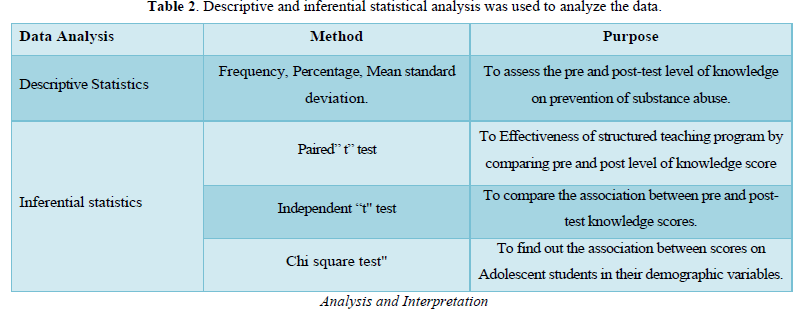
Data analysis and interpretation is the process of assigning meaning to the collected information and determining the conclusions, significance and implications of the findings. In all research studies follows data collection. This section deals with analysis and interpretation of the information collected from 60 students’ junior college, the purpose of the study was to evaluate the effectiveness of structured teaching program on knowledge regarding prevention of substance abuse among adolescents at selected junior college, sangareddy dist. Evaluate before and after knowledge level.
Objectives of the study are to assess the level of knowledge regarding prevention of substance abuse among adolescents at selected junior college, Sangareddy by pretest.
- To develop and administer structure teaching program prevention of substance abuse among adolescents at selected junior college, Sangareddy.
- To evaluate the effectiveness of structure teaching program prevention of substance abuse among adolescents at selected junior college, Sangareddy by posttest.
- To find out association between knowledge regarding prevention of substance abuse among adolescents at selected junior college, Sangareddy and selected socio demographic variables.
Part-A
Assess the demographic variables among Adolescent students [13-14] (Table 3).

Table 3 Shows that out of 60 Adolescent students 0 (0.0%) were in the age group 12-13 years. 3(5.0%) were in the age group 14-15 years. 27(45.0%) were in the age of 18 and above years (Figure 1).
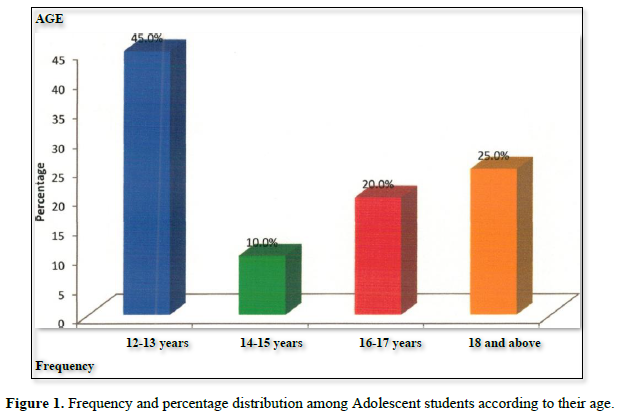
Table 4 shows that majority of 60 Adolescent students 27(45.0%) were Hindus, 6(10.0%) were. Muslims, 12(20.0%) were Christians, were others (Figure 2).

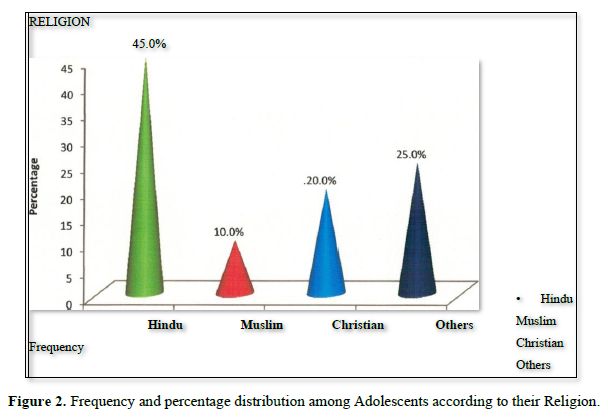
Table 5 shows that out of 60 Adolescent students 27(45.0%) are illiterate, 15(25.5%) had. Primary education, 12(25%) had Secondary education, 16(10%) had higher education (Figure 3).

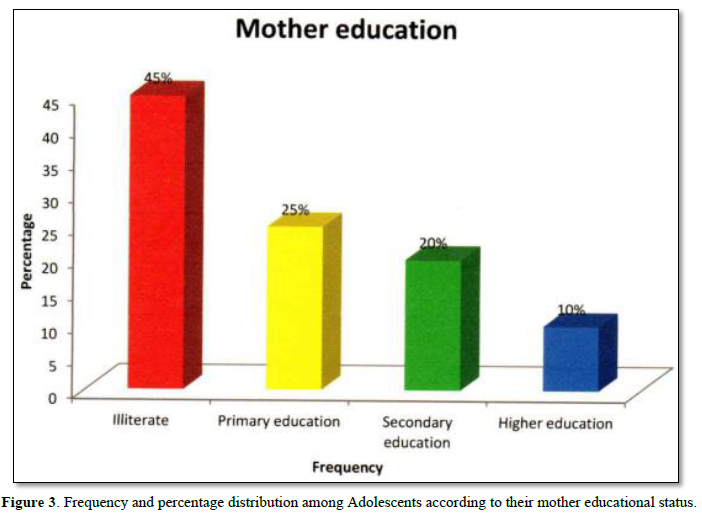
Table 6 shows that out of 60 Adolescent students 24(40.0%) are housewife, 12(10.0%) are private employee, had Primary, 6(20.0%) are Govt employee, 18(30.0%) are coolie in occupation (Figure 4).
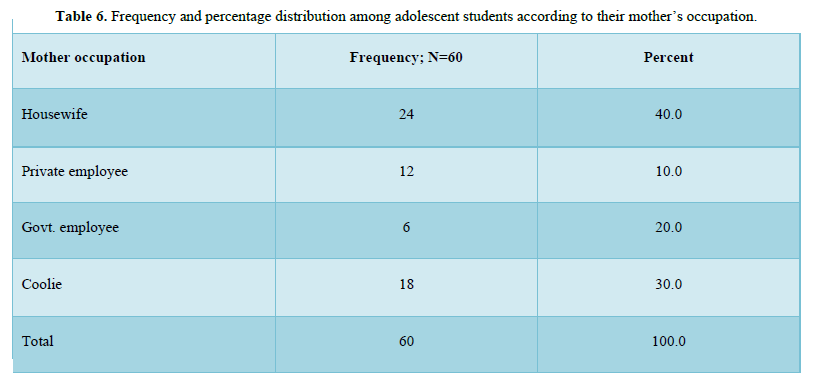
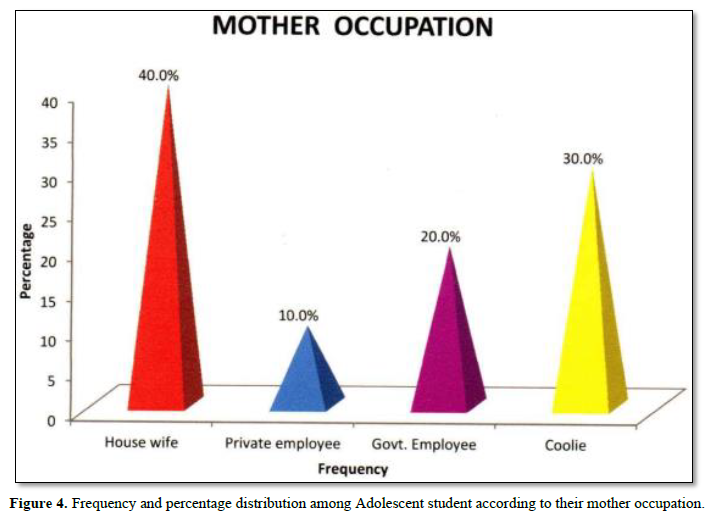
Table 7 shows that of 60 Adolescent students 21 (35.0%) are illiterate, 12(20.0%) had primary education, 18(30.0%) had secondary education, had higher education (Figure 5).
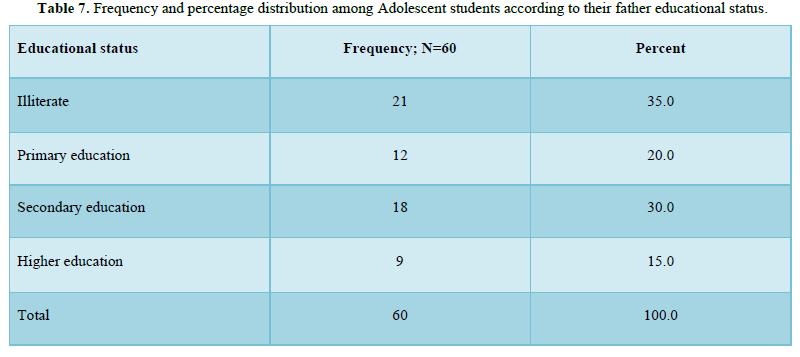
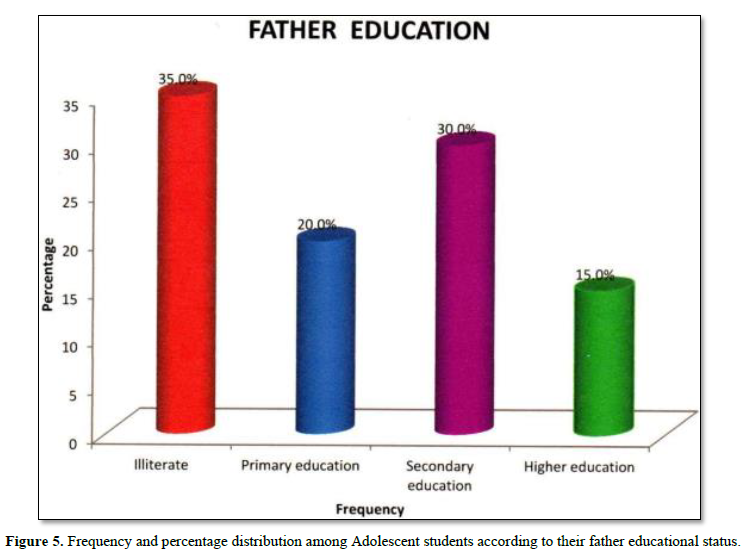
Table 8 shows that out of 60 adolescent students 6 (10.0%) were belong to businessman, 27(45.0%) were belongs to private employee, 9 (15.0%) were belong to Government employees, 18 (30.0%) were belong to coolie (Figure 6).
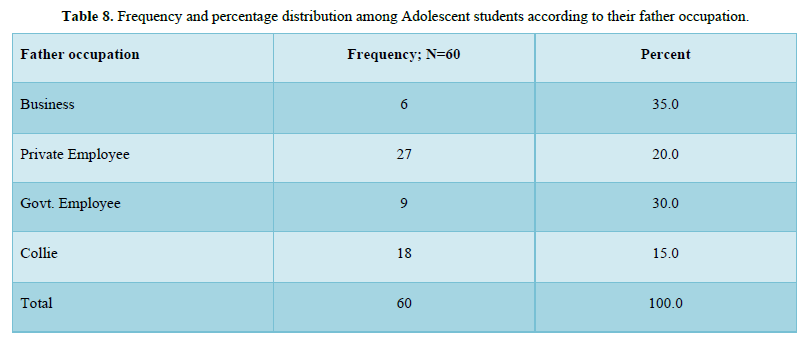
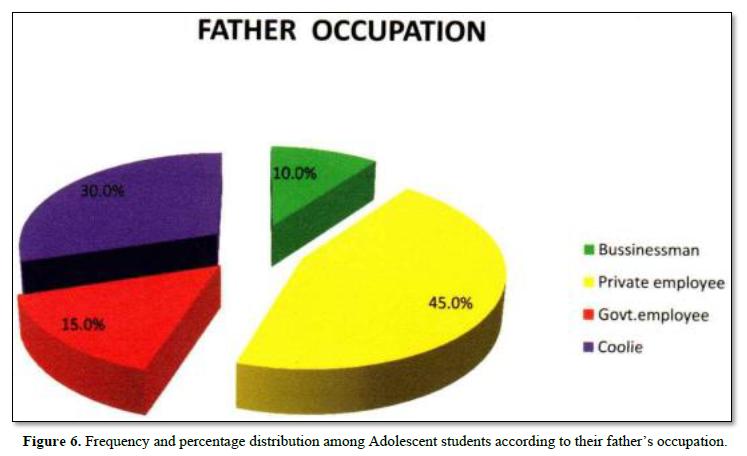
Table 9 shows that of 60 Adolescent students. 33 (55.0%) belong to 5000-10000 income, 18)30.0%) belong to 10001-15000 income, 9 (15.0%) belong to 15001 and above income (Figure 7).
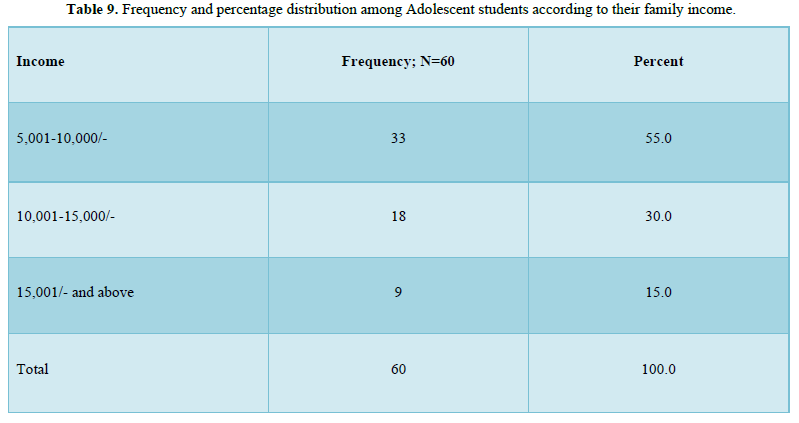
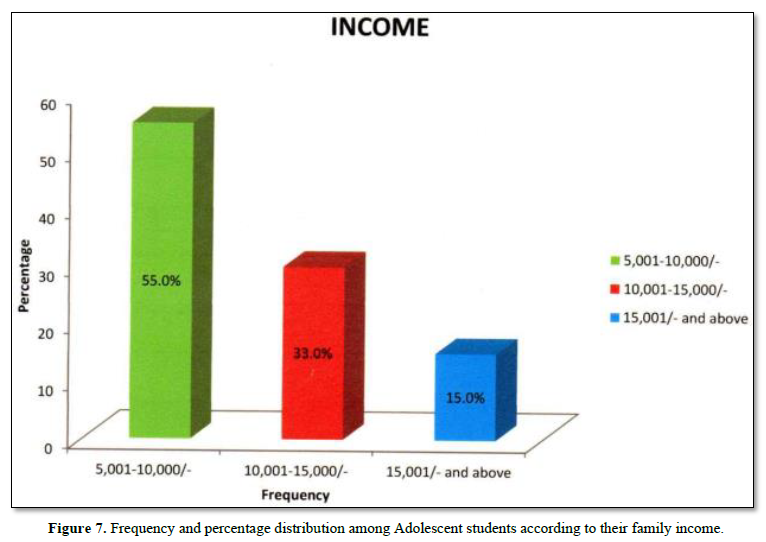
Table 10 shows that out of 60 Adolescent students 18 (30.0%) belonged to urban residents, 42 (70.0%) belonged to rural residents (Figure 8).
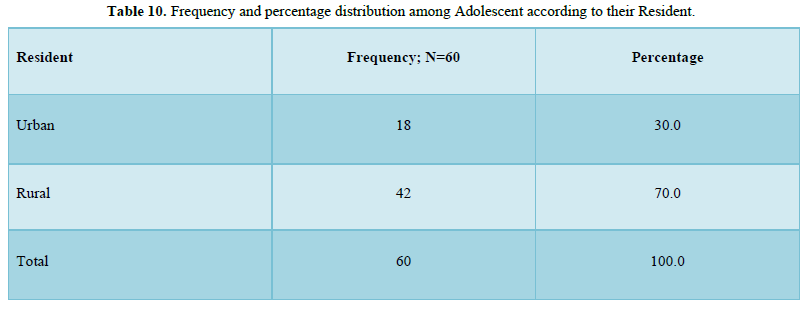
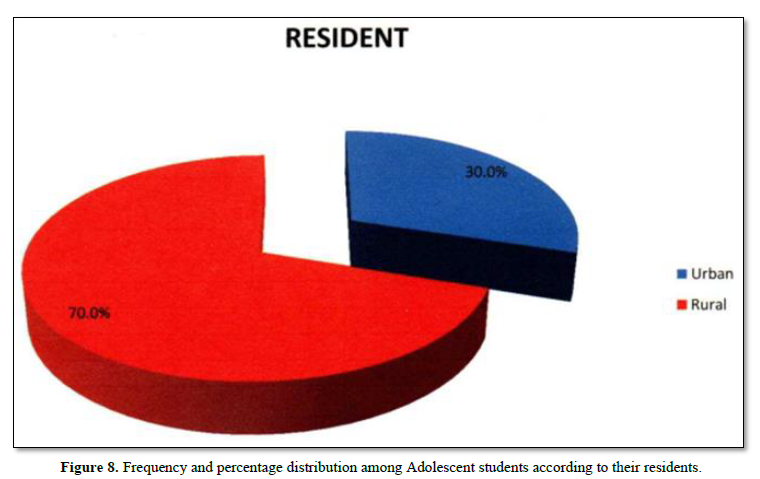
Table 11 shows that out of 60 adolescent students 9(15.0%) belonged to two, 21 (35.0%) belonged to three 18(30.0%) belonged to four ,12(20.0%) belonged to more than four family size (Figure 9).
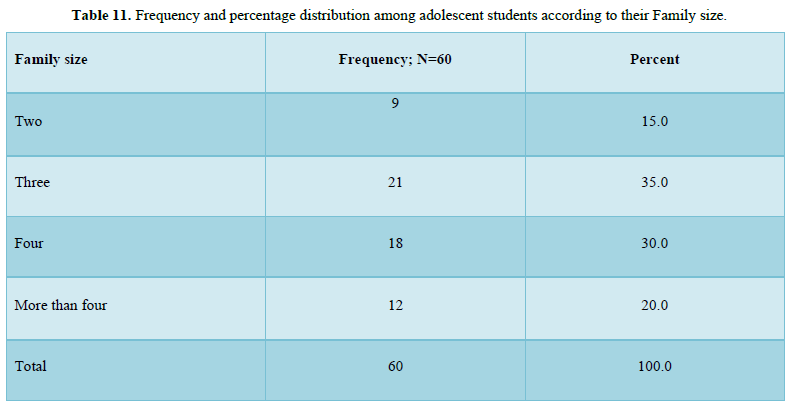
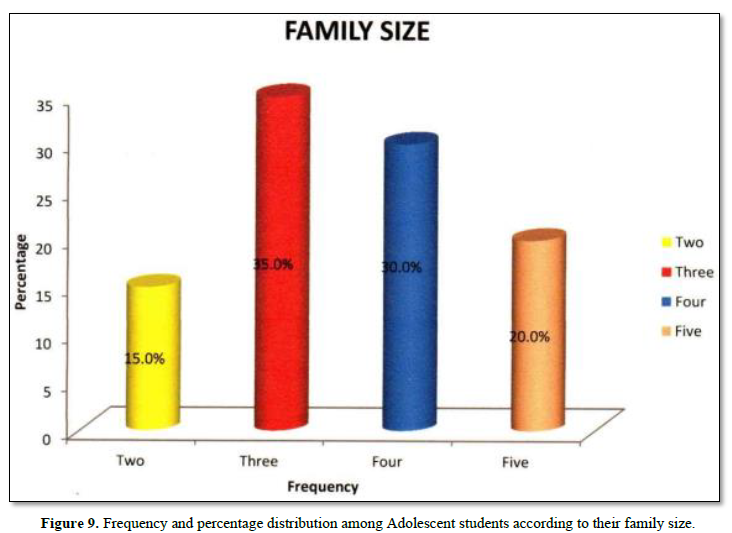
Table 12 shows that out of 60 adolescent students 27(45.0%) were belong to joint family 18(30.0%) belongs to nuclear family, 15(25.0%) belongs to single family (Figure 10).
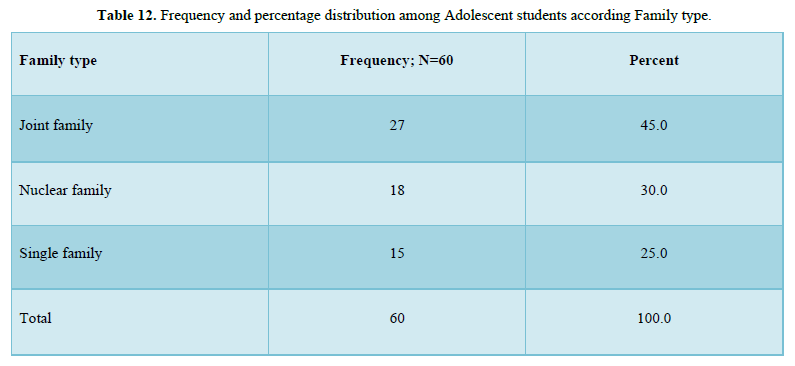
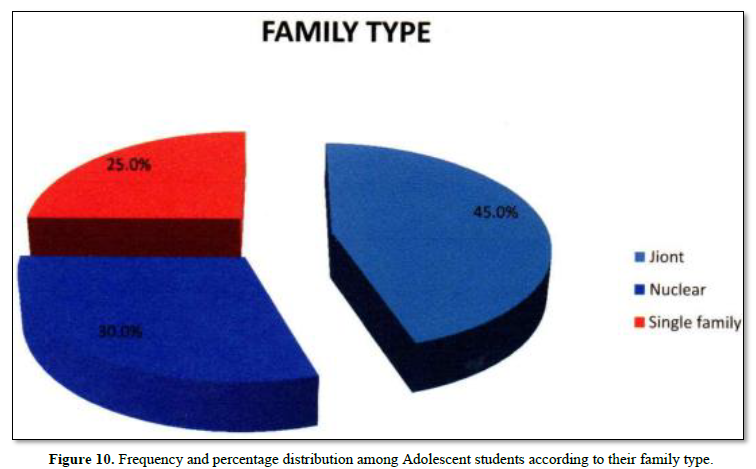
Table 13 shows that out of 60 Adolescent students 6 (10.0%) received information from teachers, 18 (30.0%) received information from parents, 30 (50.0%) received information from mass media, 6 (10.0%) received information from friends (Figure 11).
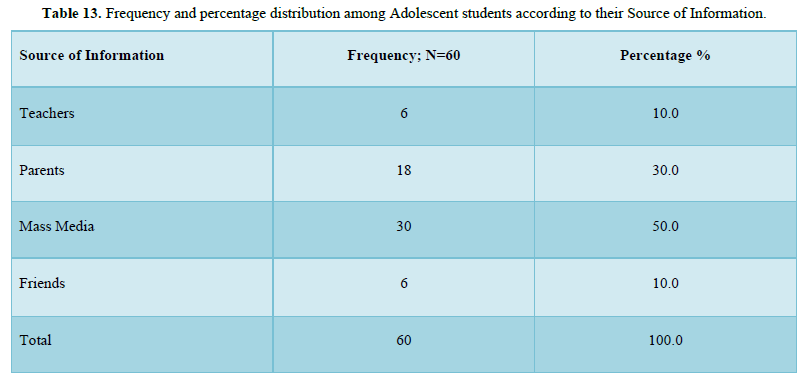
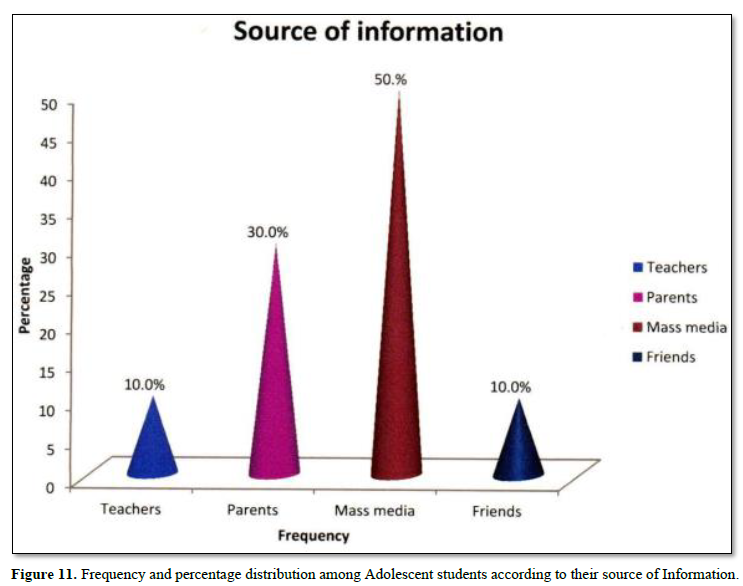
Table 14 shows that out of 60 adolescent students pretest mean score is 11.71 (19.55%) standar deviation score is 3.24(5.4%), Range score is 11(18.33%), Minimum value is 07(11.666%), Maximum value is 18(30%) (Figure 12).

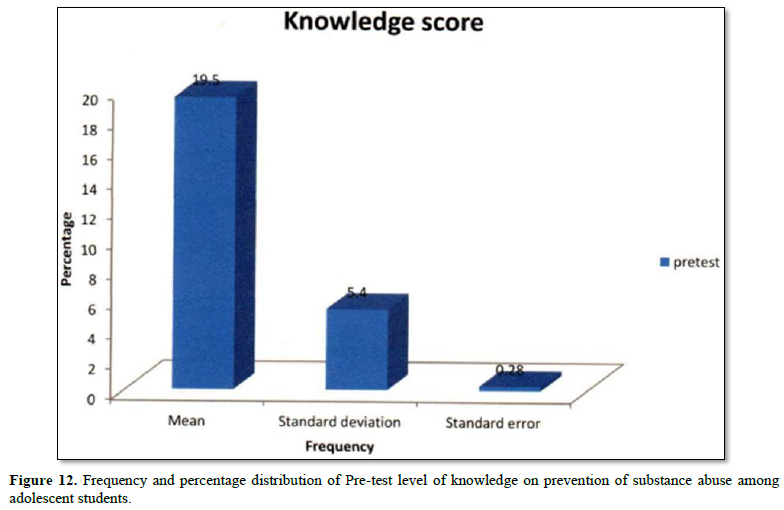
Part B
Table 15 shows that out 60 Adolescent students posttest mean score is 26 (43.33%) standard deviation score is 22.64 (38.233%) range score is 11 (18.333%) minimum value is 21 (35%) maximum value is 32 (53.333%) (Figure 13).
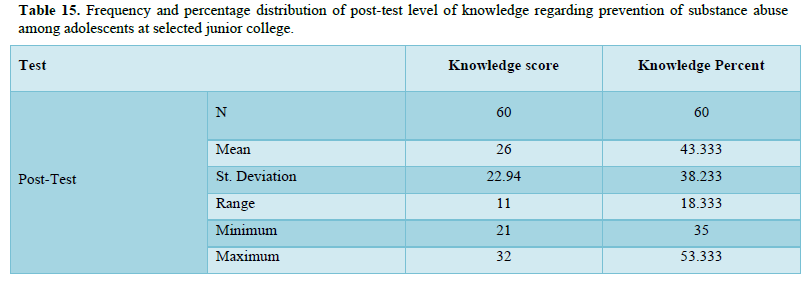
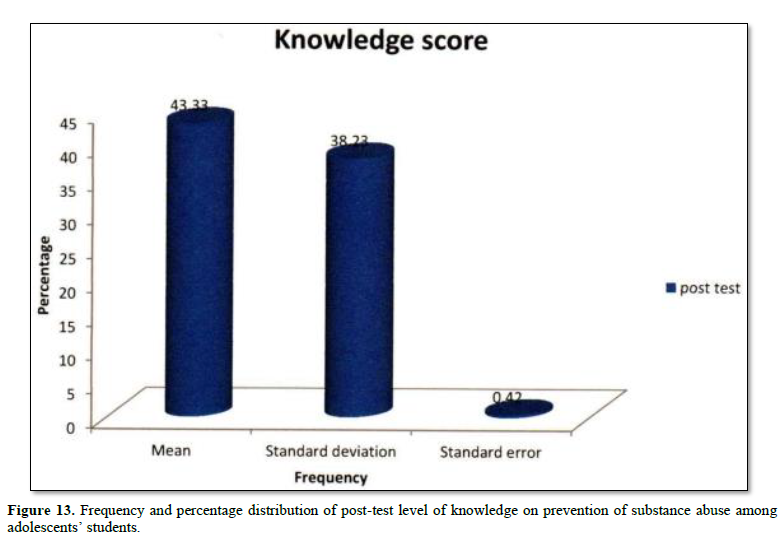
Part C
Table 16 shows that pretest 54(90%) were having Below average knowledge, 6(10%) were having. Average knowledge, 0(0%) were having Above average knowledge. For posttest 0(0.0%) were having Below average knowledge, 46(76.7%) were having Average knowledge, 14(23.3%) were having Above average knowledge (Figure 14).
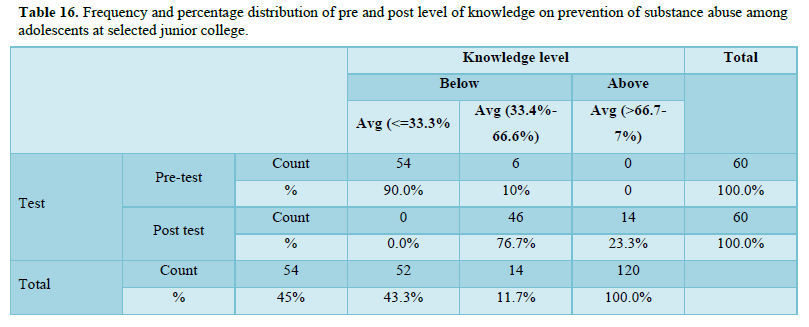
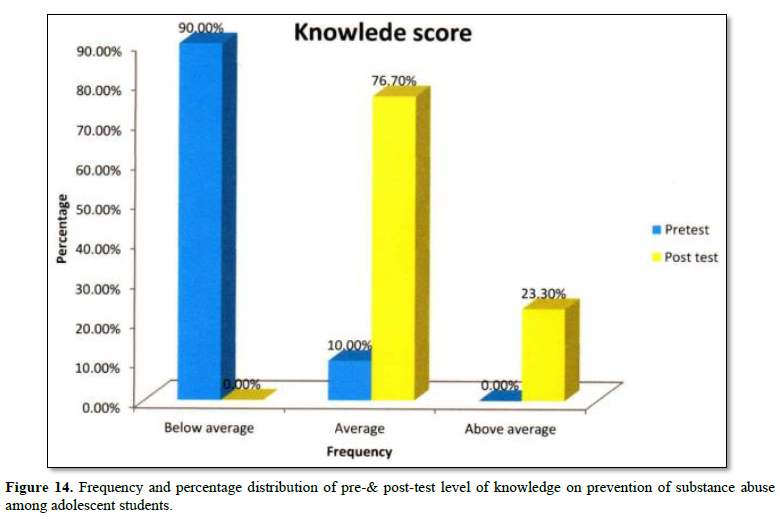
Part D
To compare the pre and post level of knowledge regarding prevention of substance abuse among adolescent students [14-15].
Table 17 shows that mean post test score of knowledge 26 with standard deviation 2.94, were significantly higher than mean pre-test score of knowledge 1 1.71 with standard deviation of the paired ‘t’ 51.35.
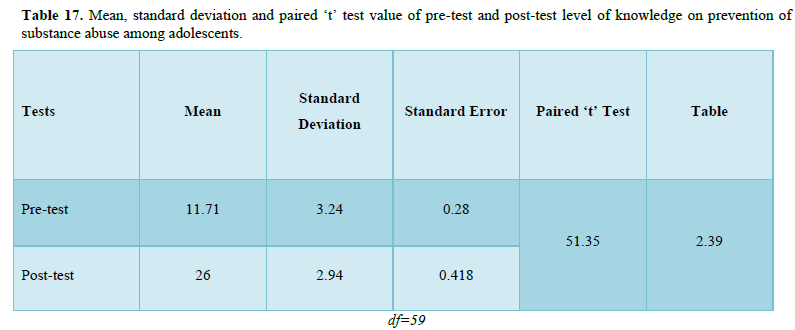
Part E
The association between post level of knowledge on prevention of substance abuse among adolescents’ students with their selected demographic variables (Table 18).
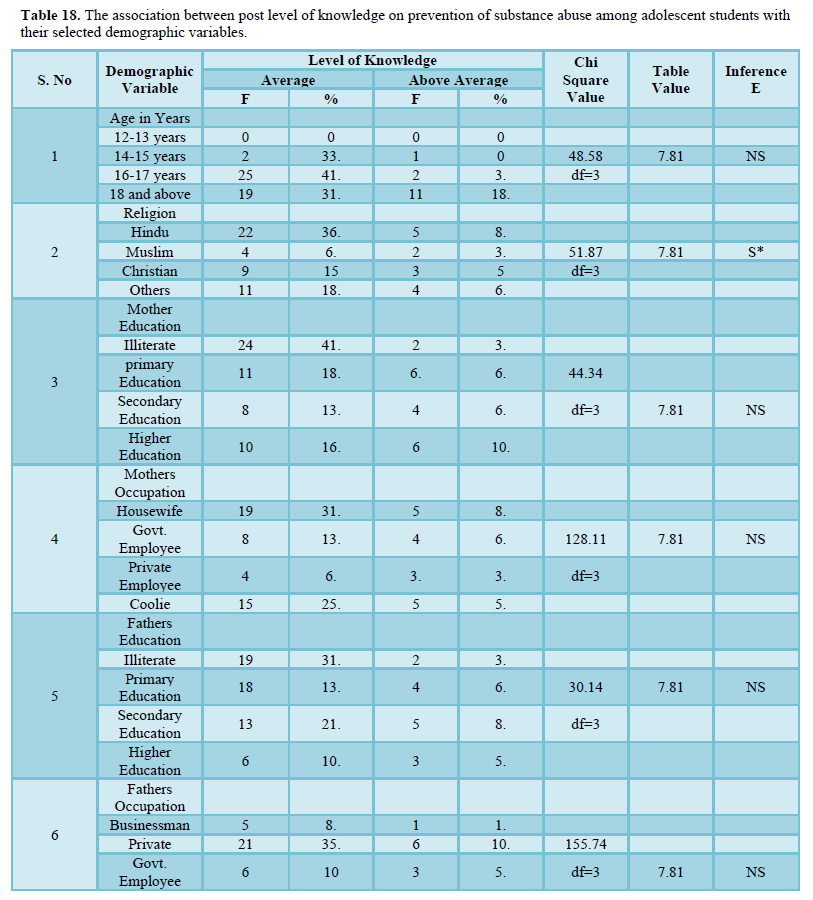
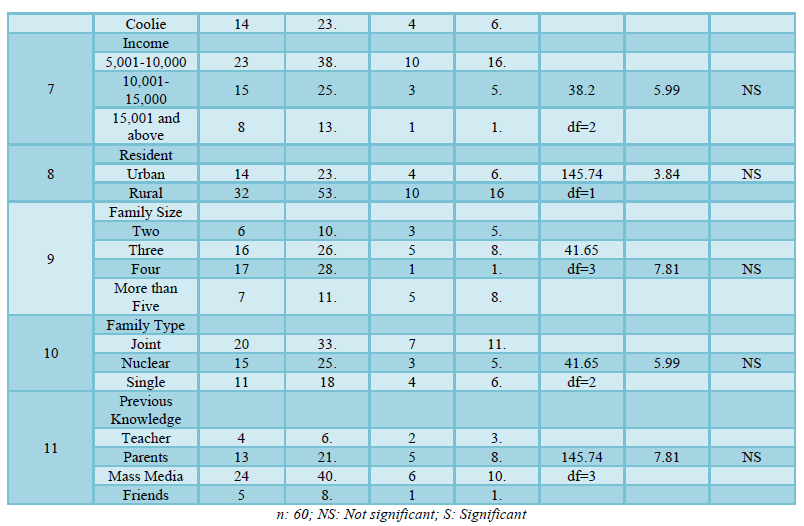
The above table revealed that demographic variable such as Age, Religion, Educational qualification of mother, occupation of mother, educational qualification of father, occupation of father, Income per month, Resident, Family size, Family type, Previous knowledge on substance abuse and had no association with knowledge on prevention of substance abuse. Except Religion has association with knowledge.
SUMMARY
The Study was conducted to assess the knowledge towards prevention of substance abuse among adolescents at selected junior college, Sangareddy, Telangana state. Descriptive research approach was used for this study sample size were 60. The conceptual framework used for this study was J.W. Kenny's open system model are input, throughput, output, and feedback convenient sampling technique were used select the Adolescent junior college students. Structured teaching program was given to Junior college students to evaluate knowledge on prevention of substance abuse at selected junior colleges. The collected data were analyzed with the help of descriptive and inferential statistics.
Major findings of the study: The findings were discussed under the following objectives. The study assesses the demographic variable regarding prevention of substance abuse among adolescent students.
- Majority of the Adolescent students 30(50.00%) were in the age group of (17-18) yrs.
- Majority of the of Adolescent students 27(45.0%) Hindus.
- Majority of the of the Adolescent student’s mother’s education 27(45.0%) were Illiterates.
- Majority of the of the Adolescent student’s mother’s occupation 24(40%) were Housewife.
- Majority of the of the Adolescent students Fathers education 21(35.0%) were Illiterates.
- Majority of the of the Adolescent students Fathers occupation 27(45.0%) were private emp.
- Majority of the of the Adolescent students Income per month 33(55.0%) were belongs to 5,001/-10,000/- income per month.
- Majority of the of the Adolescent student’s resident 42(70.0%) were belongs to rural resident.
- Majority of the Adolescent students 21(35.00%) belongs to three family members.
- Majority of the Adolescent students Family type 27(45.00%) were Joint family type.
- Majority of the Adolescent students 30(50.0%) had previous knowledge through mass media.
To assess the pre and post level of knowledge regarding prevention of substance abuse among adolescents at selected junior college. Data analyzed showed that 54(90%) were having below average knowledge. 6(10%) were having Average knowledge in pre-test were as in posttest 0(0%) have below average 46(76.7%) have Average and 14(23.3%) have adequate knowledge.
To compare the pre and post level of knowledge regarding prevention of substance abuse among adolescents at selected junior college. Data analyzed shows that mean post test score of knowledge 76.79 with standard deviation of 6.78 was significantly higher than the mean pre-test score of knowledge 31.08 with standard deviation of 11.11, the paired 't' value was 51.35 which was significantly at 0.05 level.
Therefore H1: There will be significantly increase in the post -test level of knowledge on prevention of substance abuse among adolescents’ students was accepted.
To compare the post level of knowledge regarding prevention of substance abuse among adolescent students. Therefore, there will be significant difference in the post-test level of knowledge on prevention of substance abuse among adolescents’ students was accepted. To find out the association between variables in post-test level of knowledge among Adolescent students with their selected demographic variables. Chi-square value showed that, demographic variables such as age, religion, educational qualification of mothers and fathers, occupation of mothers and fathers. Family income per month, resident. family size, family type, source of information on substance a therefore 114: there will be significant association between post-test knowledge on prevention of substance abuse among adolescent students with their selected demographic variable.
CONCLUSION
The study was conducted to assess the level of knowledge among Adolescent students at selected junior colleges. knowledge Mean score was 76.79 with standard deviation 6.795 so the structured teaching program was an effective method to improve the knowledge [15].
Implications in nursing: The findings of the study have been implemented in four areas such as nursing practice, nursing education, nursing administration and nursing research.
Nursing Education: Nurse educators need to provide adequate knowledge towards prevention of substance abuse among adolescent students by providing information, it can be by teaching. Every Phase of nursing-educator will be influenced by the philosophy upon which it is based philosophy takes in all aspects of human life with the view in regulating and protecting life. Their offer is the primary concept of the nurse. From the finding of the study, it is evident that there is improvement of Adolescent students’ knowledge towards prevention of substance abuse at selected junior colleges.
Nursing Administration: Nurse Administrators can provide education to nursing personnel by conducting in-service education programs, workshops, conferences to enhance their knowledge regarding prevention of substance abuse. Nursing Administrators should take the initiative in creating policies or plans in providing education to Adolescent students. We are in changing world; today’s needs are different than yesterday’s being healthy person we should be able to bring new interventions to our society. Even though they exist in the developed countries.
Nursing Services: Nurses should maintain Standards in providing nursing care on substance abusers at adolescent students. She should improve standard of care by updating her knowledge and skills.
Nursing Research: It helps to make evidence-based nursing practice in various areas. A profession seeking to improve the practice of its members and to enhance its professional striver for the continual development of the relevant body of knowledge. Nursing research represents a critically important tool for the nursing profession to acquire such knowledge. Nursing research should be aware about existing health care system and the status of the nursing profession by conducting research and by formulating new theories, research could improve the knowledge of the midwife and ultimately, improve the status and standard of nursing.
- Poor RA (2004) A guide for prevention and treatment of substance abuse. pp: 13, 23-24, 32, 17, 53, 143, 51-54.
- Bennett LA, Campillo C, Chandrashekar CR (1998) Alcoholic beverage consumption in India, Mexico, and Nigeria: A cross-cultural comparison. Alcohol Health Res World 22: 243-252.
- Siam SH (2006) Drug abuse prevalence in male students at different universities in Rasht in Tabibe Zahedan J Res Med Sci 8: 279-284.
- Madadi A, Nogani F, Tehran J (2004) The Textbook of Addiction and Substance Abuse. pp: 10.
- D'Costa G, Nazareth I, Naik D, Vaidya R, Levy G, et (2007) Harmful alcohol use in Goa, India, and its associations with violence. A study in primary care. Alcohol Alcoholism 42(2): 131-137.
- Benegal V, Bajpai A, Basu D, Bohra N, Chattergi S, et al. (2007) Proposal to the Indian psychiatric society for adopting a specialty section on addiction medicine (alcohol and other substance abuse). Indian J Psychiatry 49: 227-282.
- Benegal V (1994) India; alcohol and public health (invited editorial) Addiction 100: 1051-1056.
- Gaunekr G, Patel V, Rane A (2005) The impact and patterns of hazardous drinking amongst male industrial workers in goa, India. Soc Psychiatry Psychiatr Epidemiol 40: 267-275.
- Shore ER (1994) Outcomes of a primary prevention project for business and professional women. J Stud Alcohol 55(6): 651-659.
- Gupta SP, Kumar N, Kumar A, Dube KC (1978) Prevalence, and pattern of drug use amongst college Acta Psychiatric Scacd 57(4): 336-356.
- Chakravorthy P (2018) A study to assess the effectiveness of planned teaching program on knowledge and attitude of mothers of mentally retarded children attending child guidance center at R.A.K. College of Nursing New Delhi. Unpublished Master of Nursing dissertation, University of Delhi.
- Ziaaaldini H, Sharifi A, Nakhaee N, Ziaaaldini AA (2018) Theat-least-once narcotics consumption prevalence among male pre-university students in Kerman city. J Addict Health Summer Autumn 2nd pp: 103-110.
- World Health Organization (1987) The selection of teaching learning materials in health sciences Tech Rep Series 538: 115-123.
- World Health Organization (1985) Self-learning material and module for health worker a guide for the development, utilization and evaluation, technical publication series.
- Neeta R (2016) A study to develop and evaluate the effectiveness of an informational booklet on care of low-birth-weight infants for the mothers whose babies are admitted in neonatal intensive care unit in selected hospitals in Delhi. Unpublished Master of Nursing dissertation, University of Delhi.
QUICK LINKS
- SUBMIT MANUSCRIPT
- RECOMMEND THE JOURNAL
-
SUBSCRIBE FOR ALERTS
RELATED JOURNALS
- BioMed Research Journal (ISSN:2578-8892)
- Archive of Obstetrics Gynecology and Reproductive Medicine (ISSN:2640-2297)
- Journal of Blood Transfusions and Diseases (ISSN:2641-4023)
- Journal of Allergy Research (ISSN:2642-326X)
- Journal of Cancer Science and Treatment (ISSN:2641-7472)
- Journal of Neurosurgery Imaging and Techniques (ISSN:2473-1943)
- Journal of Otolaryngology and Neurotology Research(ISSN:2641-6956)















